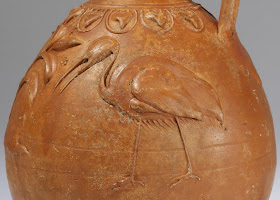The term barbotine refers to a ceramic technique in which decorative elements are either piped onto an object similar to decorating a cake, or molded then applied to a pottery vessel.
With Type A barbotine, the potter uses a quill, horn, or other kind of nozzle to apply a soft slip mixture to a ceramic piece. Today the technique is known as slip-trailing. The slip would normally be in a contrasting color to the rest of the vessel, and forms a pattern, or inscription, that is slightly raised above the main surface. Barbotine designs have been found on pottery from ancient Egypt, the Middle Minoan period on Crete, and embellishing Roman vessels, where the color may be the same as the rest of the vessel rather than contrasting.
With type B barbotine, the sllip or barbotine is cast in molds to form three-dimensional decorative sections which, when dried out, are added to the main vessel. Typically, these might be flowers, fruit, or animals. Type B barbotine was particularly popular in Britannia and the Roman provinces of Europe because of the consistency of the local clay. These vessels were probably filled with foods or liquids and given either as gifts to an elaborate burial or as offerings to a god's shrine.
 |
| Romano-British beaker, decorated in the barbotine technique with a chariot-racing scene. Made either in Colchester or in the Nene Valley region of Cambridgeshire. 2nd century CE. at the British Museum, London courtesy of Wikimedia Commons contributor AgTigress. |
 |
| The form and the single handle suggest that this jug was used for pouring wine. It is decorated in the "barbotine" technique, where a liquid clay or slip is applied in relief through a tube, much like icing is applied to a cake. Here, two stork-like birds are facing a large plant in the middle, framed by a garland of ivy leaves around the neck of the jug. Such idyllic scenes with animals and plants are typical of ceramic and metal vessels made during the time of Emperor Augustus. 1st century BCE - 1st century CE courtesy of the Walters Art Museum. |
 |
| Closeup of a Barbotine-applied decoration of a bird on a Roman jug from the Augustan Period, 1st century BCE-1st century CE courtesy of the Walters Art Museum. |
 |
| Ancient Roman beaker with hunting scene, from the castellum of the 1st Canathenian cohort in Straubing courtesy of Wikimedia Commons contributor Wolfgang Sauber. |
 |
| Ancient Roman beaker with hunting scene, from the castellum of the 1st Canathenian cohort in Straubing courtesy of Wikimedia Commons contributor Wolfgang Sauber. |
 |
| Terracotta cup with barbotine decoration, 2nd–early 3rd century C.E., Roman, at the Metropolitan Museum of Art. This cup is representative of the sort of pottery that was produced in Roman Britain, influenced by wares made in eastern Gaul and the Rhineland. The shape of the vessel and the style of the hunting scene are typical of the northwestern provinces, but barbotine decoration itself—the application of a thick clay slip to the vessel surface—is found on many different types of pottery across the Roman Empire. |
 |
| Terra Sigillata bowl with barbotine decoration in the Museum Rheinzabern courtesy of Wikimedia Commons contributor Haselburg-müller. |
 |
| "Caster Ware" Vase with Hunt Scene, Roman, mid-2nd century, courtesy of the Cleveland Museum of Art. |
 |
| Bellied pot with barbotine decoration made of novaesium, rough-walled ware, 1st century CE, Clemens-Sels-Museum, Neuss courtesy of Wikimedia Commons contributor Hartmann Linge |
 |
| Green glazed_beaker, glazed earthenware with barbotine decoration, 1st century CE, made of novaesium, Clemens-Sels-Museum, Neuss courtesy of Wikimedia Commons contributor Hartmann Linge |










No comments:
Post a Comment